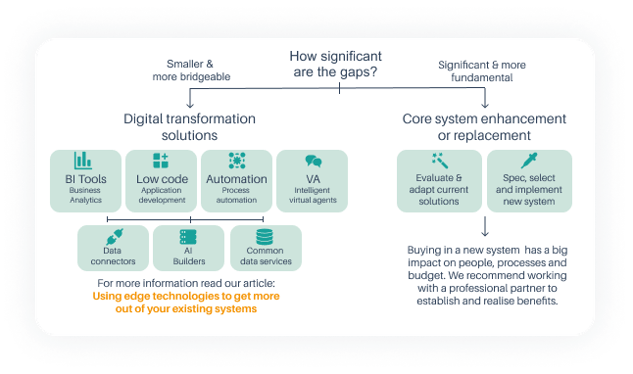The Fluid Maturity Framework sets out ten core business functions and processes, and defines five maturity levels based on the extent to which each function is supported by an application that meets requirements and is scalable and adaptable. By scoring each function against the maturity levels you build a heat map of the whole business.
This will pinpoint the functions which are least digitalised and systemised, or which are holding back business growth. Then you’ve done the groundwork to make decisions about where system improvements and investments needs to be prioritised.
Once the key gaps have been identified, the business is faced with a choice about how to close them. The best option might be to extend, or adapt current core solutions by buying in additional modules or bespoke digital development. Or the gaps may require looking at implementing new off-the-shelf solutions that fit the requirement.
Key questions to ask of the business:
- Do current systems meet key business requirements?
- Where are the biggest gaps, and what would be the benefits and costs of resolving them?
- Are current systems easily scalable to meet future growth requirements?
- What are the barriers to scalability and how can they be resolved?
What does system capability often look like in average SMEs?
Lots of SMEs are working with functions that are unsupported by any core system and processes that are manual or spread-sheet based. There is lots of repetitive data entry and off-system processing or workarounds. Where systems are in place, they confine processes, offer a poor user experience, are difficult to change, and can't be scaled easily.
What does good look like?
As the business begins to mature you start to see adoption of core systems which meet many requirements, but may still constrain processes and be difficult to change. You’ll see increasing use of Software as a Service (SaaS) solutions which allow for rapid scaling based on demand, or cloud hosting / Infrastructure as a Service (IaaS) for traditional systems hosted on a company’s own servers. SaaS and IaaS solutions often come with integrated disaster recovery, backup, and security features, reducing the demand for internal IT provision and eliminating non-value add ‘keep the lights on’ activities from the business.
The most mature businesses have systems which do an excellent job of meeting most business requirements, are easily adaptable and scalable. They have high degrees of process digitalisation and automation, and are almost entirely cloud based or SaaS with dynamic automatic scaling in real time to meet peaks and troughs in demand.
How to fill system gaps


"Our solution supplier was telling us that our problems were only teething issues that could be resolved with a bit more tweaking of the system. We commissioned an independent gap analysis of the solution against our business requirements which identified that the system was fundamentally unsuitable for our business model and requirements.
We are now working with our partners through a robust ‘spec and select’ exercise to choose a replacement system which will be a much better fit to our requirements."
Christos Panayiotou, Director, Trade Skills 4 U
